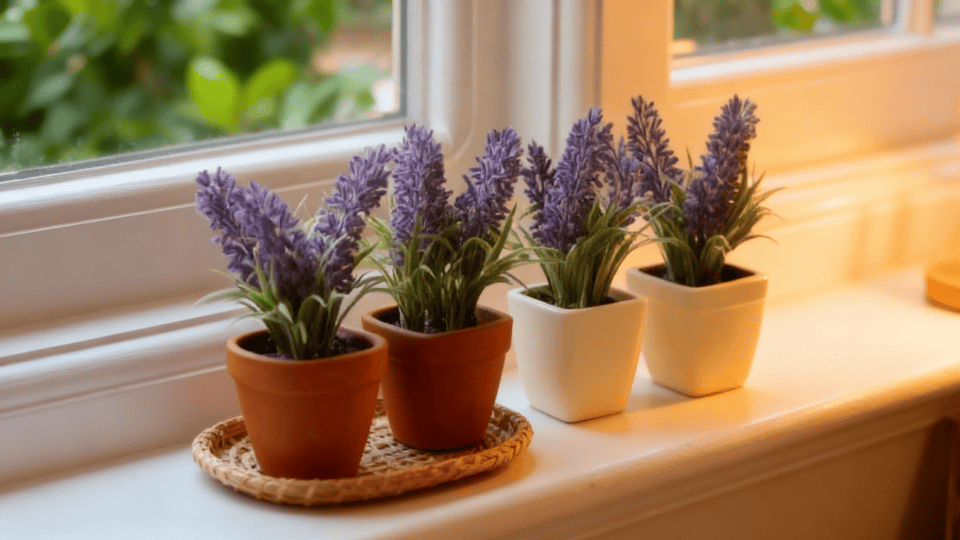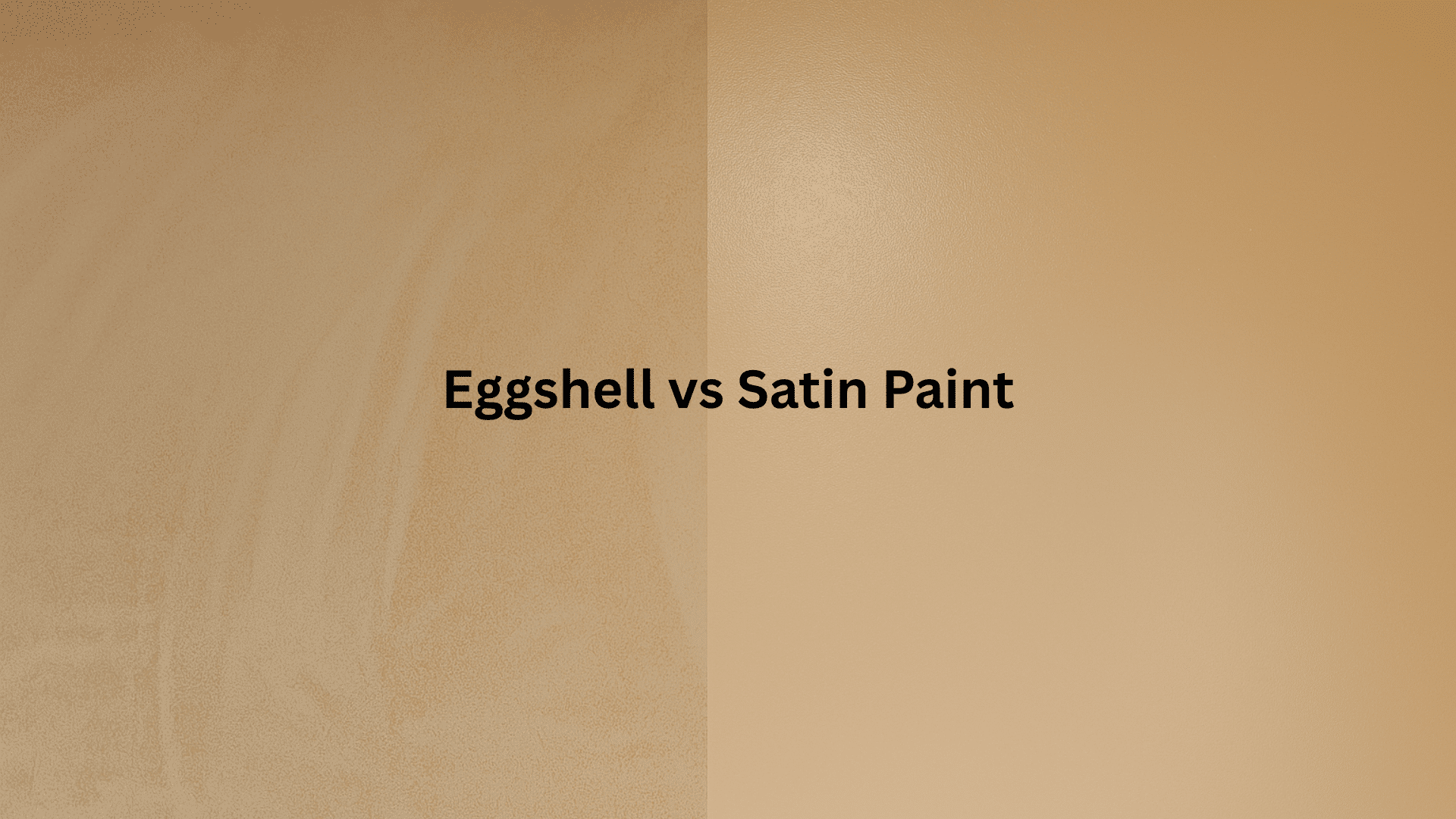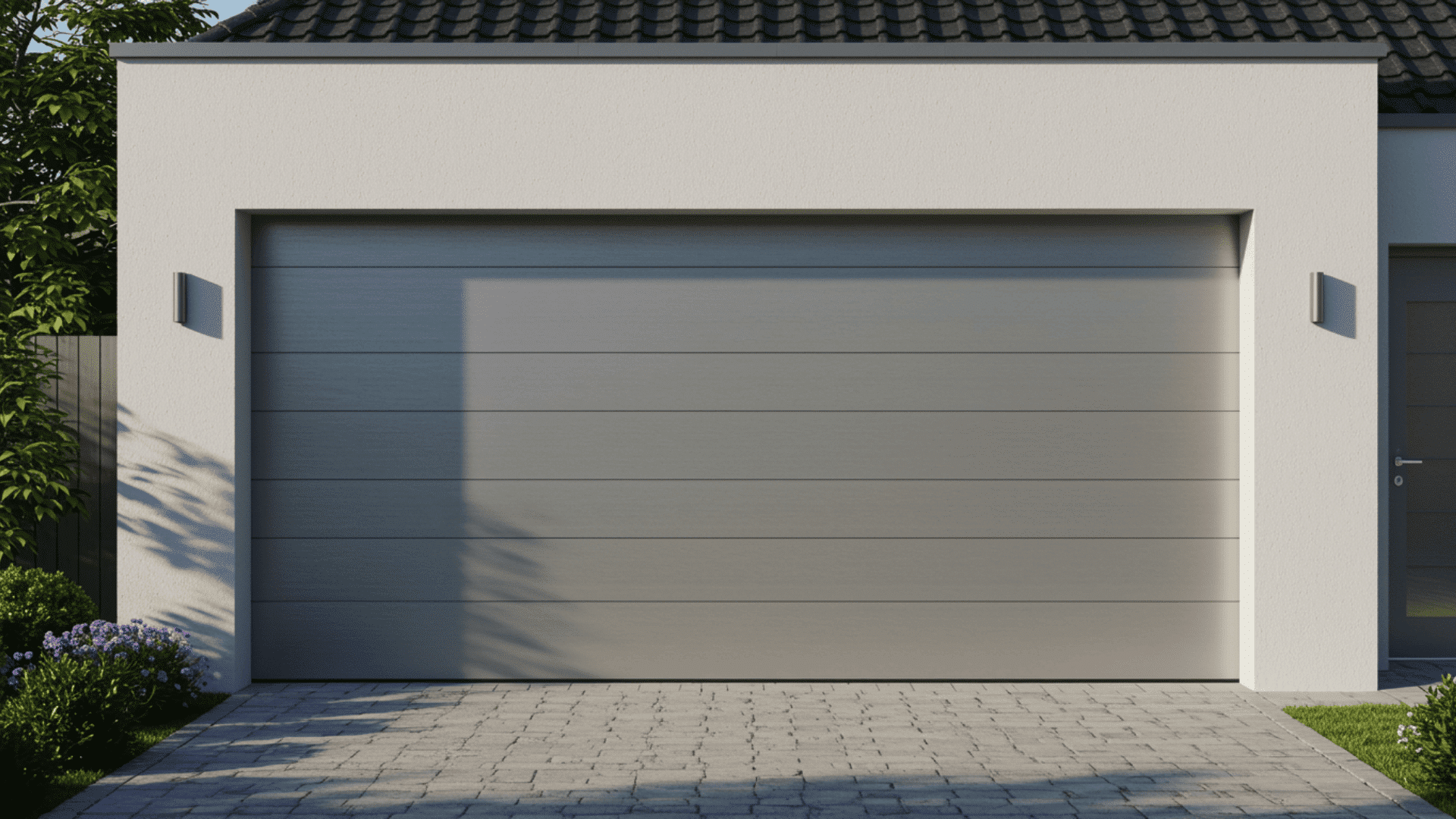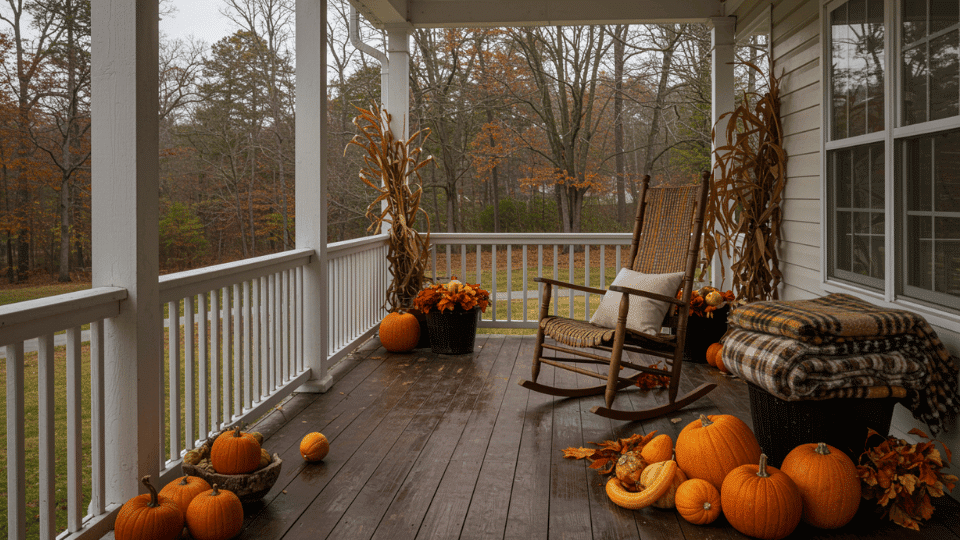Want to fill your home with calming fragrance and beautiful purple blooms year-round? Learning how to grow lavender indoors is easier than you think!
Growing lavender lets you enjoy fresh sprigs for cooking, crafting, or simply brightening up your space, no matter the season or climate.
Also, it’s a low-maintenance plant that blooms with the right care. You’ll learn everything from choosing the perfect lavender variety to mastering watering, light, and soil needs.
Seasoned gardeners and complete beginners alike can cultivate blooming lavender plants on their windowsill.
Complete Taxonomic Breakdown of Lavender
Lavender’s taxonomy reveals its place in the plant kingdom, showing how it’s related to other aromatic herbs.
| Taxonomic Rank | Classification |
|---|---|
| Kingdom | Plantae |
| Phylum | Tracheophyta |
| Class | Magnoliopsida |
| Order | Lamiales |
| Family | Lamiaceae |
| Genus | Lavandula |
| Species | Lavandula angustifolia |
Ideal Indoor Environment for Growing Lavender

Creating the right environment is crucial when learning how to grow lavender indoors. Lavender is a sun-loving Mediterranean plant that needs specific conditions to bloom indoors.
1. Light Requirements and Ideal Placement
Lavender craves bright, direct sunlight for at least 6-8 hours daily. Place your plant on a south-facing windowsill where it receives maximum sunlight.
If natural light is limited, supplement with full-spectrum grow lights positioned 6-12 inches above the plant for 12-14 hours daily.
2. Temperature and Humidity Balance
Keep temperatures between 60-70°F during the day and slightly cooler at night. Lavender prefers dry air with humidity levels around 40-50%.
Avoid placing plants near humidifiers, bathrooms, or steamy kitchens, as excessive moisture can cause root rot and fungal problems.
3. Air Circulation and Preventing Mold or Mildew
Good airflow prevents moisture buildup and the spread of fungal diseases. Position your lavender where air circulates freely, avoiding cramped corners.
Use a small fan on low speed nearby to mimic outdoor breezes. Proper spacing between plants and avoiding overwatering also keeps mold at bay.
Selecting the Right Pot and Soil

Lavender demands excellent drainage and lean soil similar to its Mediterranean origins. Standing water causes root rot, so the right pot and soil combination is essential for healthy growth and continuous blooms.
Select terracotta or clay pots 12-16 inches in diameter with multiple drainage holes.
These porous materials allow moisture to evaporate naturally, unlike plastic containers that trap water. Add a 1-2 inch gravel layer at the bottom for extra drainage, and always empty saucers after watering.
Create a well-draining soil mix by combining 2 parts potting soil with 1 part perlite or coarse sand. Lavender prefers slightly alkaline conditions with a pH between 6.5-7.5, so add lime if needed.
Avoid heavy, moisture-retaining soils or those rich in organic matter; your lavender needs lean, fast-draining conditions to bloom indoors.
Planting Lavender Indoors

Planting lavender indoors is straightforward once you know your options and follow the right steps. The key is proper technique and timing to give your lavender the best start possible in its indoor home.
1. Seeds Vs Cuttings Vs Starter Plants
Seeds are cheapest but take months to germinate and grow slowly. Cuttings root in 3-4 weeks and preserve parent plant traits. Starter plants offer instant results and are best for beginners wanting quick success.
2. Planting Process
Fill your pot with a well-draining soil mix, leaving 2 inches from the rim. Plant lavender at the same depth it was growing previously. Water thoroughly, then place in bright sunlight and let the soil dry between waterings.
3. Repotting and Transplanting Tips
Repot lavender every 1-2 years in spring when roots outgrow the container. Choose a pot one size larger with fresh soil. Gently loosen root-bound roots, replant at the same depth, and water sparingly until established.
Watering and Feeding Your Indoor Lavender
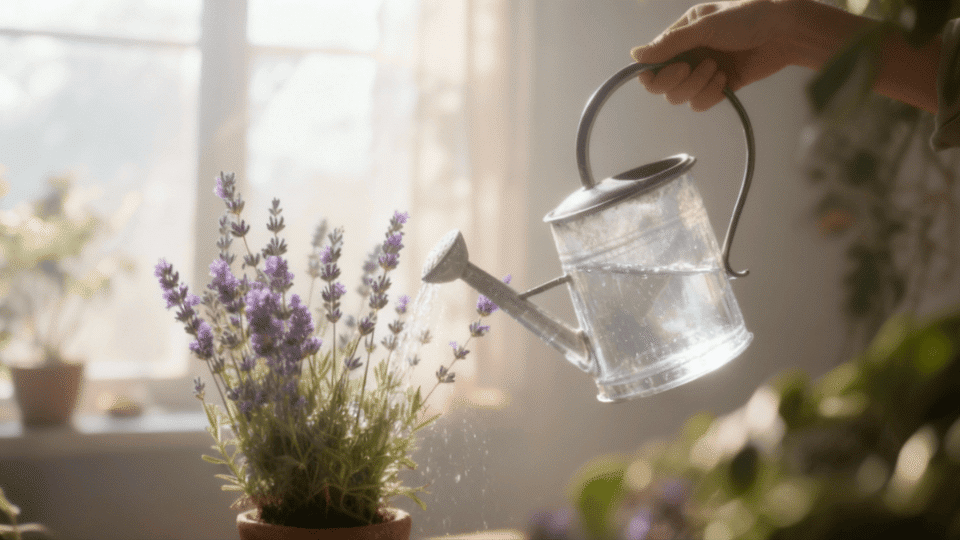
Mastering watering and feeding is essential for growing lavender indoors successfully. Lavender is drought-tolerant and prefers a “less is more” approach. Overwatering is the most common mistake that kills indoor lavender plants.
- Watering Frequency: Water only when the top 1-2 inches of soil feels completely dry to the touch, usually every 7-10 days, depending on conditions.
- Signs of Overwatering: Yellowing leaves, wilting despite wet soil, and mushy brown roots indicate overwatering and potential root rot.
- Best Fertilizers: Use a balanced liquid fertilizer diluted to half-strength once monthly during the spring and summer growing seasons.
- Avoid Over-Fertilizing: Lavender blooms in lean soil; too much nitrogen produces leggy growth with fewer flowers.
- Seasonal Adjustments: Reduce watering frequency in winter when growth slows and skip fertilizing entirely during dormancy.
Common Problems and How to Fix Them
Even with the best care, challenges can arise when growing lavender indoors. The good news is that most problems are easy to identify and fix once you know what to look for.
| Problem | Signs/Causes | Solution |
|---|---|---|
| Aphids | Tiny bugs on stems; sticky residue; curled leaves | Spray with water; apply insecticidal soap or neem oil every 3-5 days |
| Spider Mites | Fine webbing; yellow speckled leaves | Increase humidity; spray with water; treat with neem oil |
| Root Rot | Overwatering; wilting despite wet soil | Reduce watering; ensure drainage holes; repot in fresh soil |
| Yellow Leaves (Bottom) | Natural aging; nitrogen deficiency | Remove old leaves; fertilize lightly once monthly |
| Yellow Leaves (Throughout) | Overwatering; poor drainage | Let the soil dry completely; reduce watering frequency |
| Drooping Stems | Underwatering; heat stress; root-bound | Water thoroughly; move to a cooler spot; check if repotting is needed |
| Pale Leaves | Insufficient light | Move to a brighter location or add grow lights |
Harvesting and Using Your Indoor Lavender
The best part about learning growing lavender indoors? Knowing when and how to harvest ensures maximum fragrance and potency. Plus, dried lavender keeps its scent for months, giving you year-round enjoyment.
1. When to Harvest Flowers for Best Fragrance
- Harvest when flower buds form but haven’t fully opened, as oils are most concentrated
- Pick in the morning after the dew dries, but before the afternoon heat diminishes the fragrance. intensity
- Cut stems when half the buds on each spike are open. for optimal scent
- Use clean, sharp scissors or pruners and cut 2-3 inches below the flower heads to encourage more blooms, so don’t be shy about cutting regularly throughout the season
2. Drying and Storing Lavender
- Bundle 8-10 stems together with rubber bands or twine, hanging them upside down in a dark area
- Keep bundles away from direct sunlight to preserve color and fragrance. Drying takes 2-4 weeks
- Once completely dry and the stems snap easily, remove buds from stems by running fingers downward
- Store dried lavender in airtight glass jars or containers away from light and moisture
- Properly stored lavender retains fragrance for 1-2 years. Label jars with harvest dates
3. Creative Uses at Home (DIY Sachets, Oils, Décor)
- Make sachets by filling small fabric bags with dried buds place them in drawers, closets, or under pillows
- Create lavender-infused oil by steeping dried buds in carrier oil (like jojoba or sweet almond) for 4-6 weeks
- Craft decorative wreaths, bouquets, or arrangements using dried stems for natural home décor
- Add dried lavender to homemade soaps, bath salts, or sugar scrubs for spa-like treatments
- Brew lavender tea by steeping 1-2 teaspoons of buds in hot water for relaxation and better sleep
Conclusion
Now you know exactly how to grow lavender indoors and enjoy its beauty year-round!
Remember the essentials: choose the right variety, provide 6-8 hours of bright light, use well-draining soil in terracotta pots, and water only when the soil is dry.
With proper temperature, airflow, and occasional pruning, your indoor lavender will grow and reward you with fragrant blooms.
Don’t let limited outdoor space stop you from experiencing lavender’s calming scent and gorgeous purple flowers.

